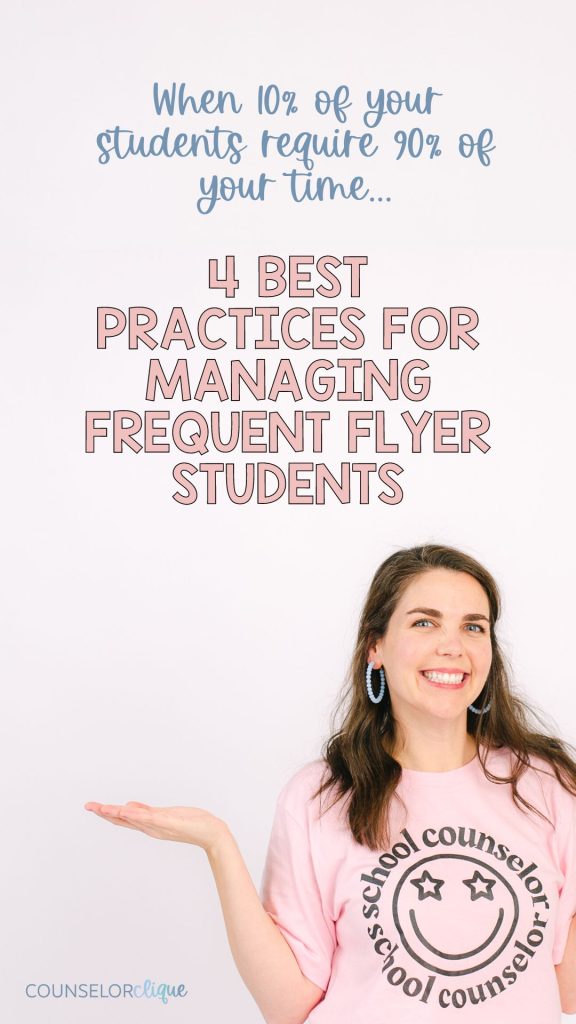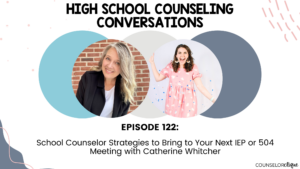A topic that is overwhelmingly popular among our counselor friends is the challenge of managing our frequent flyer students. “Frequent flyers” are a handful of students that inevitably take up the greatest share of our resources. Often we find ourselves stuck in a cycle of spending the majority of our time with just a small percentage of our caseload.
If you’re feeling this pressure, know you are not alone! It can be exhausting and discouraging to feel like you’re cheating the other 90 percent of your students who deserve attention, too. Here, I present four strategies that will help pull you out of the rut with your frequent flyer students so you can have a more balanced approach in your high school counseling caseload.

1- Prep your office environment for helpful touch points with frequent flyer students
We can all agree that our counseling office spaces need to be warm and welcoming for students. However, our frequent flyer students are known for pushing (or stomping all over) important boundaries when it comes to time in our office. Setting up a check-in desk at the front of your counseling offices is a simple change that prevents students from ambushing you at a time when you’re not ready. It also creates a protective barrier for your other students, parents, or staff members. You still want to be accessible, but you’re not a doormat.
A lobby area can create space for the student to process while they wait, while also giving you a minute to prepare to connect with the student. Many times the student is just looking for a quick touchpoint, so a check-in area allows a place for a quick chat… but may not need to turn into a full-blown meeting.
2- Get creative to manage the timing and duration of meetings with frequent flyer students
Let me blow your mind with one of my favorite frequent flyer student strategies: the walk-and-talk method. Invite these students on a route around the school or a quick walk on the way to and from class. This easy touchpoint has a very defined start and stop time. When you reach the end of your loop or the bell rings, you can wave goodbye and naturally avoid a lengthy session. I’m not saying that these students don’t ever need more quality time with you (i.e. this is not the strategy for crisis moments). But because these touch points do tend to be frequent (hence the name), you have to get creative with boundaries.
Leave them an action step or a follow-up request that is helpful for both of you. Something as simple as, “why don’t you stop by my office after that conversation with your teacher tomorrow?” Often these students just need the security that they are welcome back into your space.
Pro Tip: A little time management goes a long way! If you’ve been here awhile, you know how pumped I am about setting boundaries to make the best use of your time. If you haven’t listened to my podcast on making your digital calendar work for you, be sure to put this one on your faves list for your next commute to school.
3- Use set meeting times for intentional counseling activities with frequent flyer students
Sometimes there are underlying issues going on with frequent flyer students that keep them circling your office on a regular basis. Create space for individual counseling sessions. It could be as simple as playing a game of Jenga or Spot It while you chat. Or you may want a more structured reflection may prove to be profitable such as the anger management digital check-in or automatic negative thoughts activities in my TpT store.
After a session, send them on their way with an activity to work on that you can discuss at your next meeting such as a flipbook or journal with writing prompts. Since productivity tends to be a real challenge with these students, an intentional, individual counseling activity may be just what they need to start growing in their social emotional skills.
You can also invite your frequent flyers into small groups you want to run. I have so many resources on my TpT store to turn you into a small group wizard. For example, if you know they lost a family member, create a small group on coping with grief. Our frequent flyer students are looking for a place to belong so group sessions could be a great space to connect with other students while being equipped with tools specifically related to their situation.
4- Don’t be afraid to refer frequent flyer students to a mental health counselor
Since we counselors tend to be natural “helpers,” we can often forget that while we want to be present with our students, some situations will go beyond our scope and/or capacity. A mental health counselor can give your frequent flyer students the more intensive services they need for true healing and progress. If you’re lucky enough to have a mental health counselor on your staff, guide your student through the referral process. If not, put together a list of local therapists for students and families to look into. I always kept a bunch of extra copies on hand to help students and parents receive the dedicated help they need.
What are ways that you help manage your caseload with your frequent flyers? The discussion continues among our Clique Collaborative community. Join the membership to hear how our counselor friends are staying afloat with the constant pressures and challenges we counselors face on a daily basis.
We all know caseloads can feel impossible. Wondering where your state ranks on the list of student-to-counselor ratios? Be sure to check out ACSA’s chart for a state-to-state analysis for all sorts of fun data!
For more strategies to equip you to better serve frequent flyer students, be sure to check out podcast episode 63. Here’s to more direct flights and fewer layovers with our frequent flyers! Drop me a DM and share which tips are most helpful for you.






